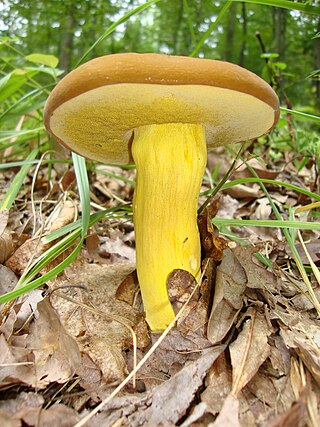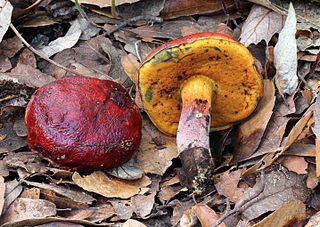
Xerocomus subtomentosus, commonly known as suede bolete, brown and yellow bolete , boring brown bolete or yellow-cracked bolete, is a species of bolete fungus in the family Boletaceae. The fungus was initially described by Carl Linnaeus in 1753 and known for many years as Boletus subtomentosus. It is edible, though not as highly regarded as other bolete mushrooms.
Boletus pseudofrostii is a species of bolete fungus in the family Boletaceae. Found in Belize, it was described as new to science in 2007.
Boletellus belizensis is a species of bolete fungus in the family Boletaceae. Found in Belize, it was described as new to science in 2007.
Boletellus domingensis is a species of bolete fungus in the family Boletaceae. Found in the Dominican Republic, it was described as new to science in 2007.
Boletus brunneopanoides is a species of bolete fungus in the family Boletaceae. Found in Belize, it was described as new to science in 2007.
Boletus neotropicus is a species of bolete fungus in the family Boletaceae. Found in Belize, it was described as new to science in 2007.
Boletus occidentalis is a species of bolete fungus in the family Boletaceae. Found growing under Pinus occidentalis in Jarabacoa, Dominican Republic, it was described as new to science in 2007.
Boletus projectelloides is a species of bolete fungus in the family Boletaceae. Found in Belize, it was described as new to science in 2007.
Boletus roseoareolatus is a species of bolete fungus in the family Boletaceae. Found in Belize, it was described as new to science in 2007.
Boletus brunneotomentosus is a species of bolete fungus in the family Boletaceae. Found in Belize, it was described as new to science in 2007.
Boletus rugulosiceps is a species of bolete fungus in the family Boletaceae. Found in Belize, it was described as new to science in 2007.
Leccinum violaceotinctum is a species of bolete fungus in the family Boletaceae. Found in Belize under Pinus caribaea and Quercus spp, it was described as new to science in 2007.
Phylloporus scabripes is a species of bolete fungus in the family Boletaceae. Found in Belize on sandy soil under Quercus spp. and Pinus caribaea, it was described as new to science in 2007.

Suillus pseudoalbivelatus is a species of bolete fungus in the family Suillaceae. Found in the Dominican Republic, it was described as new to science in 2007.
Xerocomus belizensis is a species of bolete fungus in the family Boletaceae. Found in Belize, it was described as new to science in 2007.
Xerocomus olivaceus is a species of bolete fungus in the family Boletaceae. Found in Belize on sandy soil under Coccoloba uvifera, it was described as new to science in 2007.

Boletus auripes, commonly known as the butter-foot bolete, is a species of bolete fungus in the family Boletaceae. First described from New York in 1898, the fungus is found in eastern Asia, Central America, and eastern North America from Canada to Florida. It is a mycorrhizal species and typically grows in association with oak and beech trees.

Pulvinic acids are natural chemical pigments found in some lichens, derived biosynthetically from the aromatic amino acids phenylalanine and tyrosine, via dimerization and oxidative ring-cleavage of arylpyruvic acids, a process that also produces the related pulvinones.

Rubroboletus dupainii, commonly known as Dupain's bolete, is a bolete fungus of the genus Rubroboletus. It is native to Europe, where it is threatened, and red listed in six countries. It also occurs in North America, although it is rare there. It was first recorded from North Carolina, and then from Iowa in 2009. It was reported from Belize in 2007, growing under Quercus peduncularis - a species of oak tree.

Retiboletus ornatipes, commonly known as the ornate-stalked bolete or goldstalk, is a species of bolete fungus in the family Boletaceae. Originally named Boletus ornatipes by American mycologist Charles Horton Peck in 1878, it was transferred to Retiboletus in 2002.






